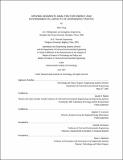Driving segments analysis for energy and environmental impacts of worsening traffic
Author(s)
Feng, Wen, Ph. D. Massachusetts Institute of Technology
DownloadFull printable version (2.497Mb)
Other Contributors
Massachusetts Institute of Technology. Technology and Policy Program.
Advisor
David H. Marks and Stephen R. Connors.
Terms of use
Metadata
Show full item recordAbstract
During the last two decades, traffic congestion in the U.S. has increased from 30% to 67% of peak period travel. Further, current research shows that measures taken within transportation systems, such as adding capacity, improving operations and managing demand, are not enough to keep congestion from growing worse. With the worsening traffic, the vehicle's fuel consumption and pollutant emissions will inevitably increase. As such, this thesis aims to quantitatively evaluate the energy and environmental impacts of worsening traffic on individual vehicles and the U.S. light-duty vehicle fleet, as well as to design feasible measures beyond transportation systems to offset theses impacts. The fuel consumption and emissions of different vehicle types under different driving situations provide the basis for analyzing the energy and environmental impacts of worsening traffic. This thesis defines the concept of "driving segments" to represent all possible driving situations which consist of vehicle speed, operation patterns and road types. For each vehicle type, its fuel consumption and emissions in different "driving segments" can be developed into a matrix by ADVISOR 2004, the vehicle simulation tool. Combining the "driving segments" vehicle performance matrices with the model for traffic congestion, the energy and environmental impacts of worsening traffic on individual vehicles can be examined. (cont.) Based on these impacts, this thesis compares the performance of different vehicle types for both today's and tomorrow's traffic situations. Meanwhile, the on-road fuel economy of each vehicle type has also been calculated to update EPA's fuel economy rating by taking worsening traffic into consideration. Combining the "driving segments" vehicle performance matrices with a set of models for fleet population, vehicle technology, driving behavior and traffic congestion, the energy and environmental impacts of worsening traffic on the U.S. light-duty vehicle fleet can also be examined. Through sensitivity analysis, this thesis investigates the effects of altering vehicle choice, developing vehicle technology and changing driving behavior on offsetting the fuel consumption and emissions of the U.S. light-duty vehicle fleet caused by worsening traffic through 2030. It is concluded that promoting the market share of advanced vehicle technologies (Hybrids mainly) is the most effective and most feasible method.
Description
Thesis (S.M.)--Massachusetts Institute of Technology, Engineering Systems Division, Technology and Policy Program; and, (S.M.)--Massachusetts Institute of Technology, Dept. of Civil and Environmental Engineering, 2007. This electronic version was submitted by the student author. The certified thesis is available in the Institute Archives and Special Collections. Includes bibliographical references (p. 143-145).
Date issued
2007Department
Massachusetts Institute of Technology. Department of Civil and Environmental Engineering; Massachusetts Institute of Technology. Engineering Systems Division; Technology and Policy ProgramPublisher
Massachusetts Institute of Technology
Keywords
Technology and Policy Program.